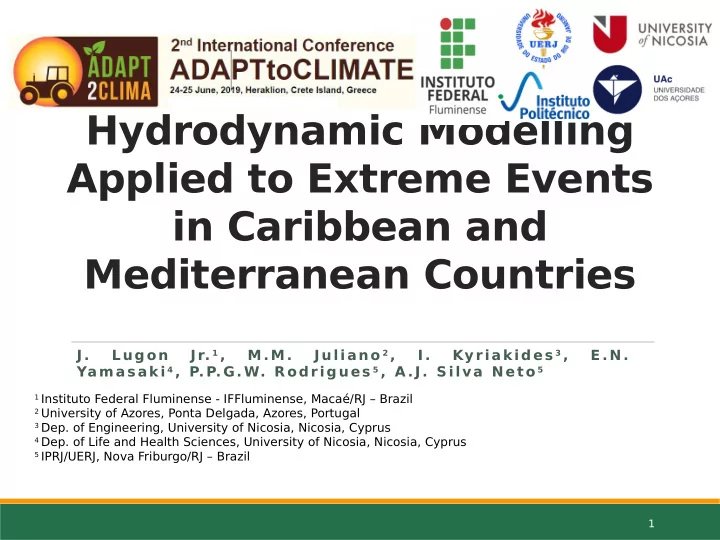

Environmental Hydrodynamic Modelling Applied to Extreme Events in Caribbean and Mediterranean Countries J. Lugon Jr. 1 , M.M. Juliano 2 , I. Kyriakides 3 , E.N. Yamas aki 4 , P.P.G.W. Rodrigues 5 , A .J. S ilva Neto 5 1 Instituto Federal Fluminense - IFFluminense, Macaé/RJ – Brazil 2 University of Azores, Ponta Delgada, Azores, Portugal 3 Dep. of Engineering, University of Nicosia, Nicosia, Cyprus 4 Dep. of Life and Health Sciences, University of Nicosia, Nicosia, Cyprus 5 IPRJ/UERJ, Nova Friburgo/RJ – Brazil 1
MAIN RESEARCH INTEREST AND TOOLS Beginning Cooperation with: Computational Modelling 1) University of Nicosia (Cyprus) Water T ransport 2) Instec (Cuba) MoHid Water Model developed to simulate MoHid surface water bodies (oceans, Hydrodynamic estuaries, reservoirs). MoHid Land Model Model with four compartments or mediums (atmosphere, porous media, soil surface, and river network) 2
INTRODUCTION Hurricanes are extreme natural events with potentially devastating effects on society, both in terms of property damage and loss of human life. In this work, the environmental hydrodynamics in the Caribbean and Mediterranean Seas are modelled using downscaling techniques on the MOHID Platform. The first critical extreme event of interest was Hurricane Irma (2017), with significant impact on Caribbean countries, such as Barbuda, Puerto Rico, and Cuba, while the second one was the Medicane Zorba, with significant impact on Greece (2018). 3
INTRODUCTION https://edition.cnn.com/s pecials/hurricane-irma 4
INTRODUCTION https://www.theguardian .com/news/2018/oct/05/w eatherwatch-greece-and- turkey-hit-by-unusual-m edicane 5
MODEL DESCRIPTION MOHID – 3D hydrodynamic computational model used to solve the Navier-Stokes equations with Boussinesq and hydrostatic approach. u i – velocity components in the cartesian components x i Ƞ - Free surface elevation; f - Coriolis parameter; v h – Turbulent viscosity; p s - atmosphere pressure; ρ – density. 6
MODEL DESCRIPTION GFS Atmospheric data COPERNICUS MyOcean Oceanic parameters GEBCO Bathymetric data 7
MODEL DESCRIPTION Horizontal Discretization Mediterranean Model Caribbean Model - 2D formulation – barotropic model 0.12 Mediterranean 0.12 Caribbean - 3D Formulation – baroclinic model 0.04 Greece 0.04 Cuba 8
MODEL DESCRIPTION Vertical Discretization Mediterranean and Caribbean Models Forcing 2D formulation – barotropic model 1 sigma layer FES2012 3D Formulation – baroclinic model 7 sigma layers and 43 Cartesian layers GFS and MyOcean 9
RESUL TS – CARIBBEAN MODEL September 8 th to 10 th , 2017: Atmospheric winds velocity & Oceanic surface currents velocity Winds GFS Caribbean Model Surface currents 10
RESUL TS – CARIBBEAN MODEL September 8 th to 10 th , 2017: Atmospheric winds velocity & Oceanic surface currents 11
RESUL TS – CARIBBEAN MODEL Water Level Results Calculated for a Virtual Station located at Isabela de Sagua, Cuba. Hurricane Irma From September 2 nd to 20 th , 2017 12
RESUL TS – MEDITERRANEAN MODEL September 27 th to 29 th , 2018: Atmospheric winds velocity & Oceanic surface currents velocity Winds GFS Surface currents Mediterranean Model 13
RESUL TS – MEDITERRANEAN MODEL September 27 th to 29 th , 2018: Atmospheric winds velocity & Oceanic surface currents 14
RESUL TS – MEDITERRANEAN MODEL Water Level Results Calculated for a Virtual Station (Kalamai) located at Kalamata, Greece - Medicane Zorba From November 28 th to October 06 th , 2018 15
RESUL TS – MEDITERRANEAN MODEL Water Level Validation Calculated for a Virtual Station (Katacolo) located at Pyrgos, Greece - Medicane Zorba From November 28 th to October 03 th , 2018 16
CONCLUSIONS The downscaling models developed allowed the simulation of the interaction between the water and the atmosphere, and the computation of the variation of the sea surface height, currents, salinity, and temperature fields. The results obtained encourages the use of MOHID´s Platform in natural disaster modelling, aiming future application to environmental parameters estimation and drift simulation of floating objects, with the formulation and solution of inverse problems. 17
CONCLUSIONS Future work: Salinity intrusion and estuarine studies in Caribbean and Salinity intrusion in Macaé River and Mediteranean modelling. estuary in Brazil. 18
ACKNOWLEDGEMENT The authors acknowledge the fjnancial support provided by FAPERJ, Fundação Carlos Chagas Filho de Amparo à Pesquisa do Estado do Rio de Janeiro, CNPq, Conselho Nacional de Desenvolvimento Científjco e T ecnológico, and CAPES, Fundação Coordenação de Aperfeiçoamento de Pessoal de Nível Superior. Thanks! 19
REFERENCES Lim, Y .-K.; Schubert, S. D.; Kovach, R; Molod, A. M.; Pawson, S. The Roles of Climate Change and Climate Variability in the 2017 Atlantic Hurricane Season, Scientifjc Reports. 8:16172 (2018). DOI:10.1038/s41598-018-34343-5. Romero, R. and Emanuel, K. Medicane risk in a changing climate. Journal of Geophysical Research: Atmospheres, 118(12), pp.5992-6001 (2013). DOI: 10.1002/jgrd.50475. Gaertner, M. Á. et al., Simulation of Medicanes over the Mediterranean Sea in a Regional Climate Model Ensemble: Impact of Ocean–atmosphere Coupling and Increased Resolution. ClimDyn 51:1041– 1057 (2018). DOI:10.1007/s00382-016-3456-1. ACTION MODULERS. Mohid Studio. [Ref. November, 21 st 2018]. Available from: http://actionmodulers.pt/products/mstudio/products-mohidstudio2015.shtml. MOHID Water Modelling System [Ref. [November, 21 st 2018]. Available from: www.mohid.com. GEBCO - General Bathymetric Chart of Oceans. Gridded bathymetry data. [ref. November, 20 th 2017]. Accessed in Web: https://www.gebco.net/data\_and\_products/gridded\_bathymetry\_data. GFS - Global Forecast System. GFS Analysis. [ref. November, 20 th 2017]. Accessed in Web: https://www.ncdc.noaa.gov/data-access/model-data/model-datasets/global-forcast-system-gfs Carrére, L.; Lyard, F .; Cancet, M.; Guillot, A., Roblout, L. FES2012: A new global tidal model taking advantage of nearly 20 years of altimetry . In proceedings of the meeting 20 Years of Altimetry, Venice. (2012). COPERNICUS. Marine Environment Monitoring Service. [ref. November, 20 th 2017]. Accessed in Web: http://marine.copernicus.eu/services-portfolio/access-to-products/?option=com\_csw\&task=results. Mellor, G.; Yamada, T. Development of a T urbulence Closure Model for Geophysical Fluid Problems. Reviews of Geophysics and Space Physics, v. 20, n.4, pp. 851-875 (1982). Moura Neto, F . D. and Silva Neto, A. J. An Introduction to Inverse Problems with Applications. Springer- Verlag Berlin Heidelberg. ISBN 978-3-642-32556-4. (2013). DOI 10.1007/978-3-642-32557-1. Permanent Service for Mean Sea Level (Isabella de Sagua Station) [ref. May, 8 th 2019] Accessed in Web https://www.psmsl.org/data/obtaining/stations/411.php. Permanent Service for Mean Sea Level (Kalamai Station) [ref. May, 8 th 2019] Accessed in Web https://www.psmsl.org/data/obtaining/stations/411.php. 20
Recommend
More recommend